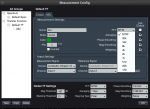I've explored Smaart 7 pretty thoroughly and I do not think there is any way to do this. Simply reducing the size of the transform -- that is using a power-of-2 length rather than "MTW" -- does not do it.
I know "horses for courses" and I have another tool, ARTA, which does this and is very nice, but Smaart is just so damn convenient.
So, first, is there a trick I'm missing? And, second, has anyone else desired this feature?
I don't think it would be too hard for the Rational folks to do. The "live" impulse response is already there. We just need the ability to multiply it by a (rectangular) window and transform it back to the frequency domain.
--Frank
I know "horses for courses" and I have another tool, ARTA, which does this and is very nice, but Smaart is just so damn convenient.
So, first, is there a trick I'm missing? And, second, has anyone else desired this feature?
I don't think it would be too hard for the Rational folks to do. The "live" impulse response is already there. We just need the ability to multiply it by a (rectangular) window and transform it back to the frequency domain.
--Frank



